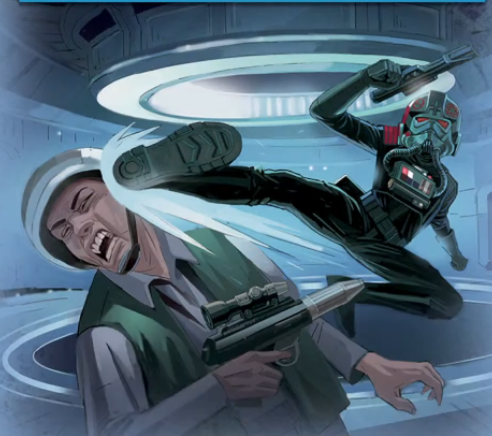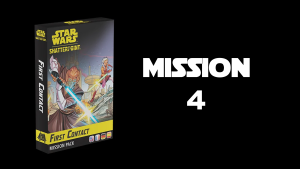Welcome back to our series of articles discussing Fantasy Flight’s upcoming Star Wars: Unlimited TCG! In the past, we featured a general introduction to the game, a look at deckbuilding and aspects, and a review of Star Wars Unlimited’s initiative system and what actions are available on a turn.
This month, I want to direct your attention to the concepts from a classic Magic: the Gathering strategy article that is relevant in many card games — Michael Flores’s “Who’s the Beatdown”, written all the way back in 1999 (perhaps before some readers were even born!) but still extremely useful! Michael truly did a service to the TCG community with this writing.
However, his article was written using Magic: the Gathering examples, and old Magic: the Gathering examples at that — so I’m setting forth to write my own version that should hopefully be more clear to Star Wars: Unlimited players. Credit for the original articulation of the core concepts here should rest with Michael!
With that out of the way, let’s get to the meat of the article!
Why Ask Who’s the Beatdown?
In many situations, one player is the beatdown — the player attempting to attack the opponent and close out the game as quickly as possible; the other player is the control, trying to stabilize the situation and prevent the beatdown player from winning the game. The question of who’s the beatdown can be very important to figuring out how to play a certain matchup.
In fact, answering this question correctly can be critical to winning the game. As Michael says in his original article, Misassignment of Role = Game Loss.
That might sound extreme. However, I think this is often the level of mistake that getting one’s role wrong can represent. Sure, sometimes you can figure it out later and switch to the right game plan in time to salvage the situation, but that might be too late. If you’ve erroneously thought your deck is faster than Sabine and switch to trying to control her units rather than “racing” for base damage only after taking substantial damage, you may well be unable to get back on track in time!
Conversely, if you were playing a fast Sabine deck and thought it was important to keep your opponent’s board small and clear their units rather than pushing damage to their base, you might find yourself in for a nasty surprise as they start playing more powerful endgame cards — and while it’s possible you’d be able to turn it around and get enough damage to win, you’d probably have been in a better spot if you were attacking aggressively from the getgo!
Asking “who’s the beatdown” can also be very relevant to sideboarding decisions. If your deck normally prefers to be the beatdown but have to play control in some matchups, you may want to add sideboard cards that help you with that role — similarly, if you’d rather play control but know there are some matchups where you have to be the beatdown instead, some more aggressive cards in the sideboard might be a good pick!
Sideboarding can be especially helpful for this sort of thing because it allows you to include cards that aren’t in your deck normally (so they don’t dilute your main strategy) but can still be included in matchups where you need to switch up your plans.
How Do You Know Who’s the Beatdown?
So, given the importance of asking the question, how do you tell who’s the beatdown? In some situations these roles can be pretty apparent. For instance, let’s say a Cunning Sabine aggro build that wants to close the game quickly and doesn’t play anything that costs more than four resources is playing against a Command Vader ramp deck that wants to build up its resources and play powerful endgame cards.
In this case, Sabine is the beatdown and Vader is the control — not too complicated. Vader’s endgame is far stronger than Sabine’s, and if Vader gets to that endgame he will likely win — so the Vader player needs to play defensively and try to make the game go long, while the Sabine player needs to play aggressively and try and close the game quickly.
However, there are also situations that are somewhat less clear. For example, if that same Cunning Sabine aggro build is playing against an Aggression Leia aggro build, which one is the beatdown and which one is the control? Both decks would like to attack aggressively!
Michael offers a few suggestions for evaluating these more difficult cases, writing that the player with more damage usually has to be the beatdown, that the player with more removal usually has to be the control, and finally that the player with more permission and card drawing almost always has to be the control. (‘Permission’ refers to cards that can counter opposing cards before they take effect — think Counterspell and the like, a category thankfully not present in SWU right now!)
Michael’s rules, while designed for Magic, largely apply to Star Wars Unlimited as well. In SWU, the player with more damage might be the player who can push more damage to base — whether that be with aggressive units or with direct damage to base via cards like For a Cause I Believe In. The player with more removal is pretty straightforward — who has more removal cards in their deck?
On the other hand, the “permission and card drawing” rule doesn’t apply as much in SWU, where card draw isn’t quite as important as in some other games and permission doesn’t exist (yet?) — however, I have three rules of my own to add to Michael’s contributions!
First, in matchups where starting HP is not equal, the player with more HP on their base usually has to be the beatdown; the player with fewer HP on their base usually has to be control.
In other words, if you’re running a 30 HP base and your opponent is running a 25 HP base, a race favors you — you don’t have to run as far to get to the finish line, after all! All you have to do is 25 damage, while your opponent needs to inflict 30. This means that if both sides ignore controlling each other’s boards and just race, you’re going to start off ahead!
Conversely, if you have a 25 HP base against a 30 HP, you’re starting off behind in a race and probably want to try and control the board — thankfully, you have an ability on your base in order to help do that!
My second rule is also fairly simple — in matchups where one player has considerably more access to Sentinels and/or healing — especially early game Sentinels — the player with more Sentinels and/or healing usually has to be the control.
Units with Sentinel force unit conflict by preventing opposing units from just swinging for the base. As a result, playing Sentinels lends itself towards playing control rather than aggro, since control wants to force unit interactions and aggro would rather just go for the base.
Similarly, healing effects allow you more time to stabilize before your opponent destroys your base. Cards like Repair or various Restore units can be helpful at buying you additional time, but they usually aren’t very efficient on offense compared to other options. This means healing lends itself to playing control.
Lastly, my third rule is that in matchups where one leader deploys before the other, the player whose leader deploys first usually has to be the beatdown.
Deploying your leader is a major power spike in Star Wars Unlimited, and it’s important to consider this when evaluating who’s the beatdown — if you deploy your leader before your opponent, especially if it’s significantly before your opponent, you can get that power spike first and try to gain an advantage at least in the short term.
Five Rules For Determining Who’s the Beatdown
If we combine Michael’s first two rules from his article and combine them with the three Star Wars Unlimited-specific rules that I’ve added above, we end up with five rules for determining who’s the beatdown. Here they are again all in one place:
- The player with more damage usually has to be the beatdown.
- The player with more removal usually has to be the control.
- The player with more HP on their base usually has to be the beatdown.
- The player with more Sentinels and/or healing usually has to be the control.
- The player whose leader deploys first usually has to be the beatdown.
So let’s ask this question to the matchup we considered earlier — Cunning Sabine vs. Aggression Leia, who’s the beatdown? Well, let’s think about the rules Mark proposed plus the two I’ve added:
Which player has more damage? The two are probably similar — they run a lot of the same cards, after all — but in general Sabine is a bit faster thanks to Cunning cards like Surprise Strike and Millennium Falcon, Piece of Junk, while Leia’s Command component doesn’t provide as much speed/aggression. That points towards Sabine being the beatdown.
Which player has more removal? Aggression Leia tends to have more thanks to Tarkintown and Admiral Ackbar, and additionally may run both Open Fire and Strike True as sideboard (or even maindeck!) options — Cunning Sabine might have some but not all of these cards available, though it might have more short-term disruption. That points towards Leia being the control.
Which player has more HP on their base? Aggression Leia generally plays the 25 HP base Tarkintown, while my Cunning Sabine builds have begun running the 30 HP Administrator’s Tower — so this points towards Sabine being the beatdown.
Which player has more Sentinels and/or healing? Cunning Sabine usually doesn’t have Sentinels or healing at all, while Aggression Leia likely has Echo Base Defender in maindeck and Bright Hope, The Last Transport in either maindeck or sideboard, plus potential healing from Ackbar. This points towards Leia being the control.
Whose leader deploys first? Sabine deploys on four resources, while Leia deploys on five — this points towards Sabine being the beatdown.
Based on these criteria, it thus seems that in the matchup between Cunning Sabine and Aggression Leia, Sabine is the beatdown and Leia is the control. That means that the Sabine player should focus on trying to push damage to the base, while the Leia player should try to get control of the board and hold off Sabine’s early aggression. To see these principles in action, check out this video I recorded earlier!
What to Do When You’re The Beatdown
So, let’s say you’ve determined that you’re the beatdown and your opponent is the control. What do you want to do in that situation? Well, the main thing is to focus on attacking the enemy base. Use your units to push damage to the base directly rather than confronting opposing units when you can get away with it — yes, in some cases the opponent might play a Sentinel or unit with major Restore that you will want to prioritize, but generally the base should be your target.
One interesting exception can be if you and the opponent deploy units where whoever attacks the other will win. For example, if each player plays a Green Squadron A-Wing, the player who attacks the other can get the kill first — this unit’s 1/3 statline with Raid 2 means that it can defeat another copy of itself while only taking one damage! A similar principle holds true with Sabine Wren, Explosives Artist.
In that sort of situation, even if you’re the beatdown you might want to attack the opponent’s unit and get the kill, since your opponent will be able to do the same to you if you don’t hit them and winning that exchange may be more valuable for you in the short run!
Additionally, there can be some benefit to clearing units with considerable Restore values, fighting enemy Sentinel units that are preventing you from attacking the base, and so on — but generally the beatdown player should be less focused on fighting for the board and more focused on just trying to reduce the opponent’s base to 0 HP and win the game!
However, in some cases the beatdown player may “lose the board”. In that case, they may need to rely on “reach” cards that deal direct damage to the opponent’s base without requiring attacks, or on units that can come into play ready or otherwise potentially sneak extra damage in before the opponent can come up with a good response.
What to Do When You’re the Control
Conversely, when you’re the control player you should be focused on trying to clear out the opponent’s units, get defenses in place, and outlast their early aggression. Instead of attacking the enemy base, you should often use your units to fight your opponent’s units and try to get them off the field. In fact, damage to the enemy base is so not the priority that it can often be better to take the initiative rather than attacking the opponent’s base.
Your goal, after all, is to stabilize the board. Getting another two or three damage with a unit that doesn’t have an opposing unit to fight is nice, but taking the initiative might mean you get to use a removal card on an enemy unit in the other arena before it gets to attack and damage your base. Saving your base HP should be prioritized over damaging the opponent’s base for a control deck — after all, if you can stabilize and execute your endgame you have a huge advantage!
When you’re the control, units with the Sentinel and/or Restore keywords (or other means of healing) are great. Sentinels help prevent your opponent from getting damage through to your base, while Restore units can repair damage the opponent has already inflicted — or, if you control one arena and your opponent the other, they can “slow down” your opponent by healing away the base even while it still gets hit from the other side!
However, eventually it comes time to switch things around and win the game. This leads to the concept of a “pivot turn” — the time when you switch from being on the defensive to having stabilized enough to launch a counterattack of your own and start threatening the opponent’s base. This can be important because unless you have major healing available, a prolonged game where you always defend might just lead to your opponent destroying your base with their reach cards.
Wrapping it All Up
So, that’s the core concept — going into each matchup, one should ask “who’s the beatdown?” If that ends up being you, you should generally focus on trying to attack and destroy the opponent’s base rather than trading units; if, however, you ask yourself “who’s the beatdown?” and the answer ends up being your opponent, you should focus on trying to control the game and stop your opponent’s damage.
These are fairly broad strategic concepts, but they can be really helpful when put into action. Thanks for reading and stay tuned for more Star Wars Unlimited content here at The Fifth Trooper as we approach the game’s release in March!





